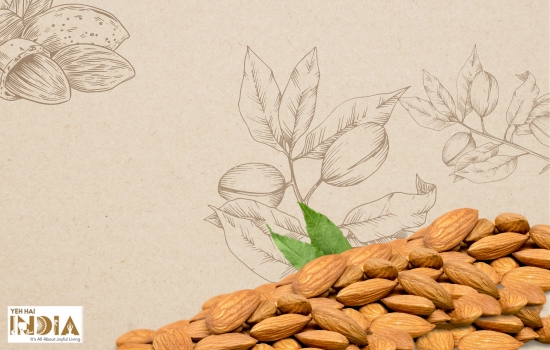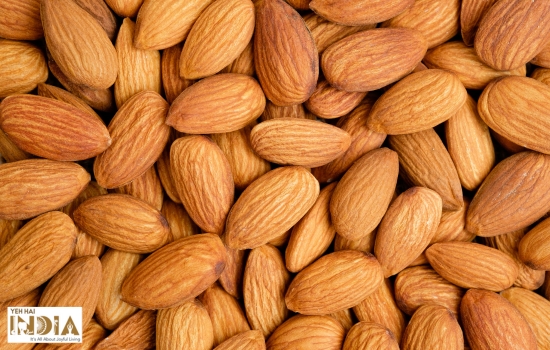Almond or Badam is a nostalgic part of childhood Indian households, as we were fed them in either soaked form, or as Badam Milkshake, Ice cream and Halwa. Some of us were even force-fed as they are traditionally believed to improve cognitive health and brain power, especially for kids.
Almond is considered the “The King of Dry Fruits”. They thrive in regions with Mediterranean climates characterized by warm, dry summers and mild, wet winters. The ideal temperature range for their growth falls between 15 and 30 °C.
Almonds – A Brief History
Almonds have a rich historical background dating back to 1400 BC in Greek mythology and the Bible.
In ancient Rome, almonds were considered fertility charms, and newlyweds were showered with them, similar to the modern tradition of giving sugared almonds in North America.
From the 7th to 9th century AD, almond trees thrived in regions such as Spain, Morocco, Greece, and Israel. The almond harvests along these areas nourished explorers travelling along the Silk Road to China.
Spain maintained a significant almond industry and continues to be one of the largest producers.
In the 1700s, Franciscan padres brought almond trees from Spain to California, although challenges with moist and cool weather delayed successful planting until the following century.
In 1890, Vincent van Gogh painted his beloved Almond Blossoms series while living in Southern France. These paintings remain highly cherished even today.
By the early 20th century, California’s almond industry was firmly established, and advancements in crossbreeding led to the development of several popular almond varieties.
Recommended Article: Suffering from PCOS? Try these Superfoods!
What does Ayurveda say about Almonds?

- Buy whole organic almonds.
- The skin is hard to digest, so soaking helps with their digestibility.
- For optimal preparation, it is recommended to soak almonds overnight and remove the skins in the morning.
- Afterwards, you can blend them with dates and raisins.
- It is advisable not to consume almonds alone on an empty stomach, but rather to incorporate them into meals along with other foods such as milk, grains, or vegetables.
Almond Varieties
3 Almond varieties are popular and commonly available in India. They are the California, Gurbandi and Mamra Almonds.
1. California Almonds

These almonds have a slightly sweet and mild flavour, making them highly versatile for various culinary uses. The sweeter taste of California almonds is a result of their chemical processing.
California almonds come in a wide range of shell hardness, kernel shapes, and surface characteristics, offering diverse options for consumers.
They are known for their larger size and smooth tan-coloured skin, dominating the almond market with approximately 85% market share.
They are favoured for cooking and garnishing purposes due to their ideal characteristics.
2. Gurbandi Almonds

Gurbandi almonds have a rich, buttery taste and are commonly used in traditional Indian sweets and desserts.
These are full of important nutrients such as omega-3, vitamin E and phytochemicals.
They contain similar nutritional content to other almond varieties, with notable amounts of magnesium, and calcium.
They are a specific variety grown in the Jammu and Kashmir region of India and are highly regarded for their unique flavour and shape.
Gurbandi almonds come in 2 forms: shelled and unshelled.
3. Mamra Almonds

They offer a rich, sweet flavour and a crunchy texture, providing a unique taste experience.
Mamra almonds are nutritionally similar to other almond varieties but may have slightly higher oil content. They are a good source of healthy fats, protein, fibre, vitamin E, magnesium, and calcium.
The higher oil content, up to 50%, compared to California almonds, typically contains 25-30% oil.
The elevated oil concentration in Mamra almonds can have a positive impact on cholesterol levels, increasing good cholesterol and reducing bad cholesterol.
While they have a lower protein content compared to California almonds, Mamra almonds are sought after for their organic cultivation without the use of chemicals.
Cultivated primarily in Iran, Afghanistan, and the Kashmir valley in India, Mamra almonds are smaller in size and have wrinkled, brownish skin.
They account for only 4% of global almond production and have distinctive characteristics.
Recommended Article: FAD DIETS: Short-term Pleasure, Long-term Regret
Other Almond Varieties
In addition to California almonds, Gurbandi almonds, and Mamra almonds, there are various other almond types available, including
- Sonora Almonds,
- Nonpareil Almonds,
- Carmel Almonds,
- Kashmiri Almonds,
- Peerless Almonds,
- Butte Almonds,
- Fritz Almonds,
- Ferraduel Almonds,
- Marcona Almonds, and
- Monterey Almonds.
Each type has its distinct characteristics and flavours, catering to diverse preferences in the almond market.
A Comparison of California, Gurbandi & Mamra Badam
| Comparison Factors | California Badam | Gurbandi Badam (Choti Giri) | Mamra Badam |
| Origin | California, United States | Middle East, Afghanistan | Middle East, Afghanistan, Jammu & Kashmir, India |
| Production Percentage | 85% | Less than 7-8% | Less than 4% |
| Cultivation/ Processing | Chemical Processing | Organic Cultivation | Organic Cultivation |
| Pasteurization | With Toxic Chemicals Like Codex Alimentarius | No | No |
| Taste | Sweeter | Moderate, a Little Bitter Sometimes | Moderate, a Little Bitter Sometimes |
| Cost | Less Costly | Costly | Costly |
| Size | Larger | Small | Small |
| Consumption Methods Recommendations | After Soaking Overnight And After Peeling Off Skin | Can be snacked directly or using the soaking method | Can be snacked directly or using the soaking method |
Best Almond Brands Available in India
Here are six recommended almond options to consider incorporating into your daily diet:
1. Happilo 100% Natural Premium Californian Almonds:
- Happilo sources its almonds directly from California almond trees.
- Almonds are handpicked to ensure quality and customer satisfaction.
- The almonds are packed in a resealable pack to maintain freshness and crunchiness.
- No preservatives, additives, GMOs, zero trans-fat, and cholesterol.
2. Amazon Brand Solimo Almonds
- Hygienically packed to meet food safety standards with no added preservatives.
- Vacuum-packed to retain freshness.
- Packed in a facility that handles other nuts and dried fruits occasionally.
3. Vedaka Popular Whole Almonds
- Fresh almonds packed in a hygienic facility complying with FSSAI food safety standards.
- Packed in food-safe material.
- Quality is assured through rigorous testing against industry standards.
4. Nutraj California Almonds
- No added flavours, preservatives, or chemicals.
- Sourced from organic farms without chemicals or pesticides.
- Stringent quality tests to ensure good quality.
- Reasonably priced.
5. Conscious Food
- Organic almonds sourced from Jammu and Kashmir.
- Chemical and pesticide-free.
- Certified 100% organic product.
Things to keep in mind while choosing a brand:
Quality and Sourcing
Look for reputable brands that prioritize quality sourcing and production methods. Ideally, the almonds should come from trusted growers or regions known for producing high-quality almonds.
Organic and Non-GMO
If you prefer organic or non-genetically modified organisms (non-GMO) products, check if the almonds are certified organic and non-GMO by relevant authorities. This ensures that the almonds were produced without the use of synthetic pesticides or genetically modified organisms.
Packaging
Consider the packaging of the almonds. Look for almonds that are sealed in airtight packaging to maintain freshness and prevent moisture or pests from entering. Transparent packaging allows you to visually inspect the almonds for any signs of damage or spoilage.
Freshness
Check the manufacturing or expiration date on the packaging. Almonds have a relatively long shelf life, but fresher almonds tend to have better taste and nutritional value. Choose almonds that are within a reasonable time frame from the production date.
Reputation and Reviews
Research the brand’s reputation and read customer reviews or feedback. Positive reviews and recommendations from other consumers can indicate the brand’s reliability and the quality of its almonds.
Price and Value
Consider the price of the almonds and compare it with other brands. While price is not always an indicator of quality, excessively low prices may suggest lower-grade almonds. Consider the overall value in terms of quality, freshness, and quantity offered.
Recommended Article: Top 10 Benefits of Eating Almonds
Health Benefits of Almonds
Apart from its taste, it offers many health benefits as they are rich in monounsaturated fats (heart-healthy fats) and help reduce bad cholesterol levels and lowers the risk of heart disease.
They also contain antioxidants and other compounds that may promote heart health.
Despite being calorie-dense, almonds have been associated with weight management. The combination of protein, fibre, and healthy fats in almonds can help increase satiety, leading to reduced calorie intake and improved weight control.
Almonds have a low glycemic index, meaning they cause a gradual rise in blood sugar levels. They can be beneficial for individuals with diabetes or those aiming to maintain stable blood sugar levels.
Almonds are a nutrient-dense food, providing a range of essential vitamins and minerals such as vitamin E, magnesium, and potassium.
The vitamin E content in almonds acts as an antioxidant, potentially protecting brain cells from oxidative stress and inflammation.
Some studies suggest that regular almond consumption may support brain health and cognitive function.
Conclusion
Almonds have an age-old history. But it also comes with numerous myths on why not to consume this miraculous nut. Everything had in excess has side effects, and so do Almonds. Consuming Almonds moderately can improve your health. Be it for Obesity, Diabetes, Hypertension or any other Metabolic syndrome.
Having a handful of almonds every day, helps everyone improve their health. Almonds are so versatile that they can go with any dish, be with sweets or mithais, or on toast, porridge, or chiwda, in roasted form.
So include this KING in your diet to Live Life King Size!!
Recommended Article: 10 Super Healthy Nuts To Include In Your Diet
Frequently Asked Questions
Which Is Better Raw Or Soaked Almond?
Soaking them in water helps soften the almonds and makes them easier to chew and digest. Soaking also activates enzymes that aid in digestion and nutrient absorption. Some people find soaked almonds to be more flavorful and enjoyable to eat.
It’s important to note that soaking almonds may slightly reduce their nutrient content, particularly water-soluble vitamins like vitamin C and certain B vitamins. However, the difference in nutrient content between soaked and raw almonds is generally minimal.
Ultimately, the decision to consume soaked or raw almonds depends on individual preference, texture preference, and any specific digestive considerations. Both options can be nutritious and provide health benefits.
Can almonds help with weight loss?
Almonds can be beneficial for weight loss when consumed as part of a balanced diet. Although they are relatively high in calories, almonds are rich in fibre, protein, and healthy fats, which contribute to increased satiety and help control appetite.
Including almonds as a snack or incorporating them into meals can help you feel fuller for longer, potentially reducing overall calorie intake. However, it’s essential to consume almonds in moderation and be mindful of portion sizes to avoid exceeding your daily caloric needs.
Are almonds suitable for people with nut allergies?
Almonds are tree nuts, and individuals with nut allergies may have adverse reactions when consuming them. Nut allergies can vary in severity, ranging from mild symptoms like itching or hives to severe allergic reactions that can be life-threatening, such as anaphylaxis.
If you have a known nut allergy, it is crucial to avoid almonds and any other nuts or nut products to prevent an allergic reaction. It is recommended to consult with a healthcare professional for specific advice regarding nut allergies.
Are raw or roasted almonds better?
Both raw and roasted almonds have their own merits. Raw almonds are considered to be in their most natural form and are not subjected to high heat during the roasting process. This helps preserve their natural nutrients, including healthy fats, vitamins, and minerals.
Roasted almonds, on the other hand, often have a more intense flavour and a crunchier texture due to the roasting process. However, roasting almonds may slightly reduce their nutrient content, particularly heat-sensitive vitamins.
Can almonds be consumed by individuals with diabetes?
Almonds can be a suitable snack option for individuals with diabetes. They have a low glycemic index, meaning they have a minimal impact on blood sugar levels. The combination of fibre, healthy fats, and protein in almonds helps slow down the digestion and absorption of carbohydrates, resulting in a more gradual rise in blood glucose levels. Consulting with a registered dietitian or healthcare professional is recommended for personalized guidance.
REFERENCES:
- A brief history of the world of almonds.
- The Pulse – A Maharishi Ayurveda View on Almonds
- Dietitian Shreya’s Family Diet Clinic – Types Of Almonds Available In India










